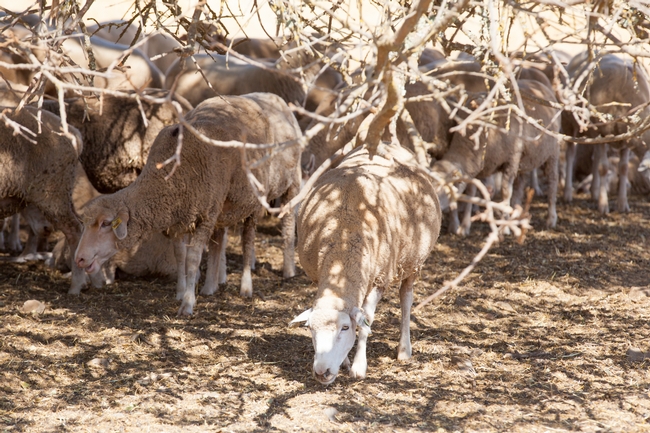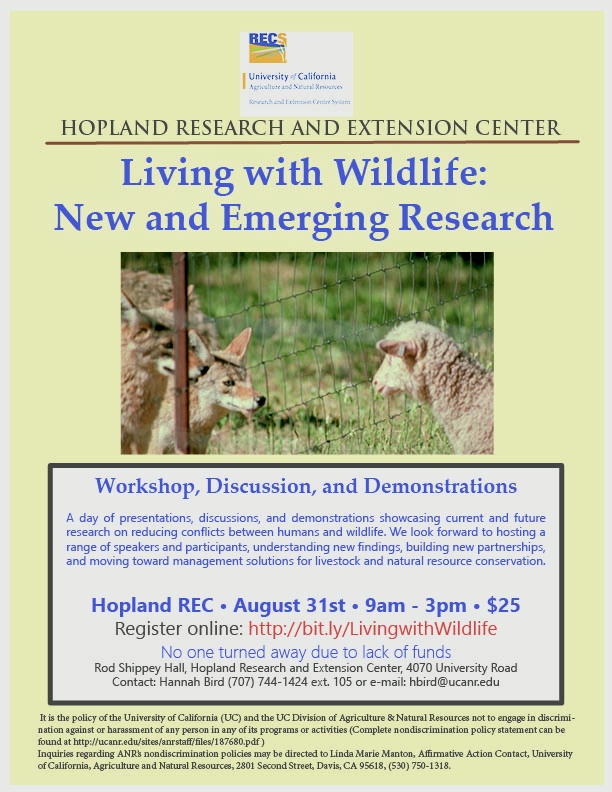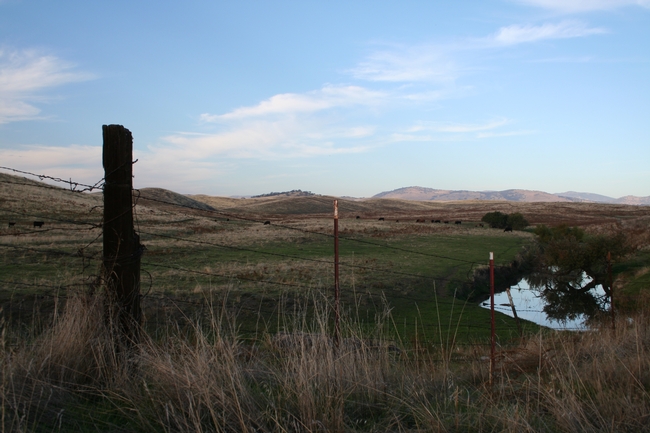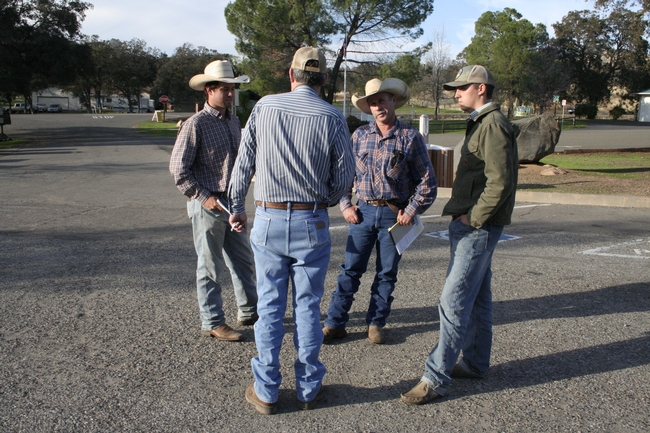
Posts Tagged: ranching
Changes to UC ANR Hopland REC Sheep Program
UC Hopland REC Reduce Sheep Flock
For over 65 years, the Hopland Research and Extension Center (HREC) has been well known as one of the last large scale sheep ranches and research facilities in the northwest. Their woolly forms are a familiar sight against the backdrop of the 5,358 acre site, well loved by the community for school field trips during the lambing season and for the sheepdog trials during the fall. In addition, they have a long history of being on the forefront of emerging research and management strategies related to sheep for topics such as: sheep biology and management, rangeland management, livestock/predator/wildlife interactions, as well as grazing as a tool for vineyard owners, fire prevention, and noxious weed control.
This summer the HREC flock will be reduced from 500 breeding ewes to approximately 125 and their full time shepherd position will be cut. The sheep will be sold at auction on the site (4070 University Road, Hopland, CA) on June 3. The sale will allow sealed bids from 8am-11am, with a minimum lot size of 20 animals. This reduction echoes a change that can been seen across the state in flock size and management styles.
Agriculture moves in cycles, following both the seasons and market demands. The sheep population in Mendocino County has fallen from 140,000 in 1954 (UCANR) to 10,400 in 2018 (USDA), and statewide sheep numbers have fallen from 2,034,000 in 1954 (UCANR) to 550,000 at the end of 2018 (USDA). As California flock numbers have declined, so has sheep research interest and funding.
Magnifying the impact of these changes, HREC is facing a significant reduction in funding from the University of California system. HREC is one of nine Research and Extension Centers (RECs) under the University of California Agriculture and Natural Resources (UC ANR) division which has seen significant budget challenges in the last few years due to flat state funding. Overall, budget reductions of $3.1 million from central (ANR) funding across the REC system are planned, and HREC's share of these cuts will amount to over 30% of its budget. The scale of this budget reduction is driving a statewide reevaluation of priorities and strategic decisions about where ANR should allocate limited funds to best meet its mission of strengthening the health of California's people, communities, food systems, and environment.
“While we must strategically adjust to financial realities and changes in research and extension priorities, we are sad to see the flock reduced and to face the coming loss of our dedicated and talented shepherd Jim Lewers. The smaller HREC flock will continue to fulfill an important role at the site, allowing us to continue to offer sheep focused educational programs and events, and to share our experience and research with sheep owners. The flock is a key tool in reducing the risk of wildfire through grazing for fire fuel reduction. Targeted grazing also helps to reduce invasive species and provides food and fiber. We plan to continue to welcome our community youth to “meet the lambs” and celebrate the services and products provided from the HREC flock at our events, for example our Wool Growers Field Day which takes place on June 1” said John Bailey, Interim Director at HREC. “We are also working to pivot our livestock programs to meet a broad array of identified research and extension needs. This will include working with private producers and potential diversifying into other species such as cattle.”
Although sheep have been considered a core feature of HREC, many other aspects of natural resource management and education are offered at the site. The diverse landscape offers oak woodland, chaparral, and riparian areas, as well as the ability to compare areas affected and unaffected by the 2018 River Fire. This landscape provides an important site for researchers from across the University of California system and beyond to study diverse aspects of the ecosystem services and working landscapes that makes California the wonderfully productive and diverse state that it is. Currently 19 research projects are studying topics including: climate change effects on soils and oaks: to tick-borne diseases: to wildlife ecology and management: rangeland ecology: fire science and sustainable land management practices.
In addition to diverse research opportunities, HRECs Community Education Specialist, Hannah Bird, has built and continues to develop a rich portfolio of extension and education events including workshops, field trips, and field classes. With the goal of educating and inspiring connection to and knowledge of diverse aspects of agriculture and natural resources, program offerings include not only sheep and wool focused events but also naturalist trainings, fire science education, birding trips, a youth summer camp, and extensive field trips which have brought over 2000 community members to the site in the past year.
“We are excited to share this wonderful site and extend the deep and broad knowledge which researchers and passionate individuals have developed about California ecosystems and agricultural systems. In this era of increasing focus on digital devices, we offer an alternative of hands-on, science-based educational opportunities for youth and people of all ages to engage with and deepen their love for our rich environmental and agricultural heritage.”
Despite the system-wide budget challenges, HREC continues to build its research and educational programs. Donor support and grants have become an integral part of their future. “Over the last year, we have been successful in obtaining grant awards from the Environmental Protection Agency with our partner REC in the Sierra Foothills for $100,000 to support fire education for middle school youth and adults, local grants to support youth education from the Mendocino Community Foundation, and individual donors have supported us with over $18,000 in 2018. Never has there been a time when such support is more needed at HREC to help us to continue to fulfill our important role in northern California.” commented Bailey in closing.
For further information regarding the sheep sale on June 3rd please visit http://bit.ly/HRECSheep . For information regarding the Wool Growers Field Day on June 1st please visit http://bit.ly/WoolGrowers . To find out more about HREC or donate to their work visit: http://hrec.ucanr.edu/ or call Hannah at (707) 744 1424 ext 105.
Living with Wildlife at Hopland REC
In December 2016 we held our first workshop to share research and allow community conversation regarding ranching in an area rich in carnivores and the challenges that this poses. On August 31st we will be offering the follow up to this event, explaining current research efforts and the new data that has been collected on various methods of predator prevention.
We hope you can join us!
Living with Wildlife: New and Emerging Research
Date: August 31, 2017
Time: 9:00 AM - 3:00 PM (Registration from 8:30am)
Event Details
A series of brief research updates by UC ANR and other UC colleagues will detail ongoing work in the science and history of non-lethal carnivore control. Field demonstrations will allow direct experience of traditional and emerging non-lethal tools, including fencing types, guardian dogs, turbo fladry, Foxlights and e-Shepherd collars. Facilitated dialogue among diverse participants will be integrated throughout the day's presentations including a rancher panel with representatives from the beef and lamb sector and from the coast to further inland. We look forward to hosting a range of speakers and participants, understanding new findings, building new partnerships, and moving toward solutions to manage for livestock and natural resource conservation.
This workshop promises to be of value to ranchers, agencies, non-profits, researchers and all those with an interest in tackling the challenges associated with ranching in a landscape rich in wildlife.
We hope you can join us at Hopland for this important and exciting event!
$25 per person, includes lunch.
No one turned away due to lack of funds - email hbird@ucanr.edu for more details
Contact: Hannah Bird (707) 744 1424 ext 105 hbird@ucanr.edu
Sponsor: Hopland Research and Extension Center/UC Berkeley
Location: Rod Shippey Hall, UC Hopland Research and Extension Center 4070 University Road, Hopland CA 95449
Grass-fed beef production a possible money-maker for Central California ranchers
The health benefits of grass-fed beef are well documented. Meat from cattle that live out their lives grazing on rangeland before being processed has more beta-carotene, vitamin E and omega-3 fatty acids than the meat from animals finished at feed lots.
The health benefits – and for some consumers, the idea that cattle raised on the range have longer, happier lives than conventional beef cattle – increases the value of the product. Grass-fed beef generally sells for 60 percent more per pound than standard beef. These potential premium prices get cattle ranchers' interest, and therefore captured the attention of UC Cooperative Extension rangeland advisor for Mariposa and Merced counties Fadzayi Mashiri.
Two major challenges face ranchers who wish to produce grass-fed beef: the lack of local processing plants, and the unfamiliar marketing strategies that successfully selling a niche product demands.
“I decided to bring ranchers together to discuss these issues,” Mashiri said. She formed a group that meets regularly in Mariposa County to discuss how they might be able to work as a team to break into the grass-fed beef market. Mashiri sees this project as an opportunity for the ranchers to diversify their sources of income and increase profit margins.
“Farm to fork is getting big,” said Marshall Long, a Mariposa County supervisor and rancher who attended the meeting this fall. “I want to keep those value-added dollars in the county.
Most of the ranchers in the valley and foothill counties of Merced, Mariposa, Madera and Fresno have cow-calf operations. After calves are born on the range, they stay on the land for about a year before being sold at auctions and fed grain or other high-carbohydrate feeds in feedlots. In grass-fed production, yearlings aren't sold, but rather kept on the land for another two years before they are processed.
The meat can be quite different. Grass-fed cattle produce meat with a distinctive flavor, less marbling, and a yellow cast. And, it commands a higher price.

“We have strength in numbers,” Schiff said.
Made in Mariposa is a potential marketing partner, or represents a model for local beef producers to emulate.
“If we think big, how big do we want to be?” Mashiri asked. “Can we work together to relieve individual producers of the pressure of selling on their own?”
The producers concluded that their next step would be a market study to determine whether stores and restaurants would be willing to pay for a ready supply of grass-fed beef. Schiff of Made in Mariposa and Mashiri will identify grant opportunities that would allow the group to move forward with the study.
Under Mashiri's leadership the ranchers will come together again in the spring to continue their planning work together to increase their businesses' bottom lines by diversifying into the production of a specialty meat product.
HREC June Newsletter NOW OUT!
Follow this link to see our June newsletter and meet our researchers!
http://us10.campaign-archive1.com/?u=32b1d74684fe8cfb160cb78a8&id=29c5f6133e&e=836c2bac99

June 2016 newsletter
Fire Season Is Not Over Yet
Local fire agencies have warned that fire season is not over. Cooler temperatures are a relief but not a stop sign for wildfire. As of last week, according to Chief Marc Bashoor at FireChief.com over 50 fires still rage in the Western United States, at varying degrees of containment, California taking the brunt of the damage. It is important that local farmers and ranchers continue to take necessary precautions against wildfires and other disasters. How can you be prepared? The following blog was written by Livestock and Natural Resource Adviser, Dan Macon.
Fire Preparation for Ranchers - Writing Down Your Plan
- Author: Dan Macon Posted: July 11, 2018. Updated Aug 27, 2018.
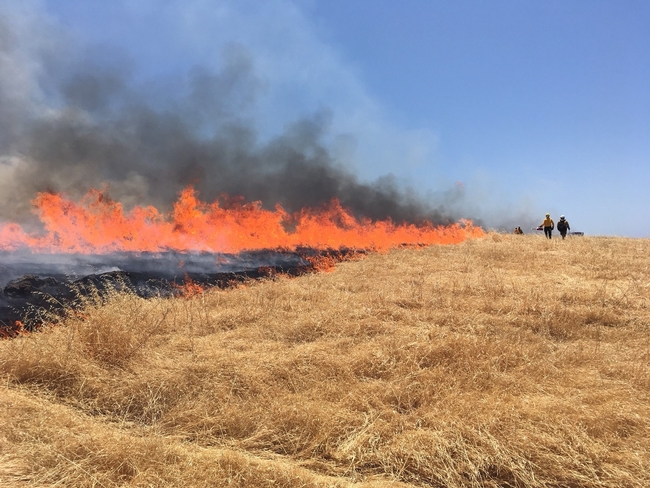
“In June, I wrote about preparing our ranches for fire (Fire Season is Here: Is Your Ranch Ready?). Since that time, we've seen large fires in ranching country. Each of these fires is a stark reminder that we live and raise livestock in a fire-prone landscape.
In July, a number of ranchers from Placer County met with law enforcement, fire and animal control officials to discuss the emergency preparation and response issues unique to commercial-scale ranching operations. As we talked, I realized that there are several factors that make planning for and responding to wildfire (and other emergencies, like flooding) challenging for these kinds of ranching businesses:
- Many ranches have livestock in multiple locations.
- Many leased pastures are simply pastures; there is no landlord or other resident on site.
- Because of this, the physical address of the pasture may not be readily apparent.
- Often, the number of livestock at a particular site may be more than can be easily evacuated in a single load in a stock trailer.
- Access during a fire may be difficult due to law enforcement road blocks. Since many of us lease pastures, gaining access (as opposed to staying at our home places in the event of an evacuation) can be problematic.
There are several things we can do to help address these issues. First, we should write down the locations where our livestock are grazing at least on a seasonal basis. What's the address? How many animals are at each location, and what classes of animals are there? What are the evacuation routes you'd be likely to use to get animals out of harms way? If you couldn't evacuate the animals, are there safe zones on or nearby the location where animals could be moved? Is there an on-site landlord or resident, or perhaps a neighbor, that you could call in an emergency situation? Finally, are there 2 or 3 nearby ranchers who could help you? Here's a sample of my one-page plan: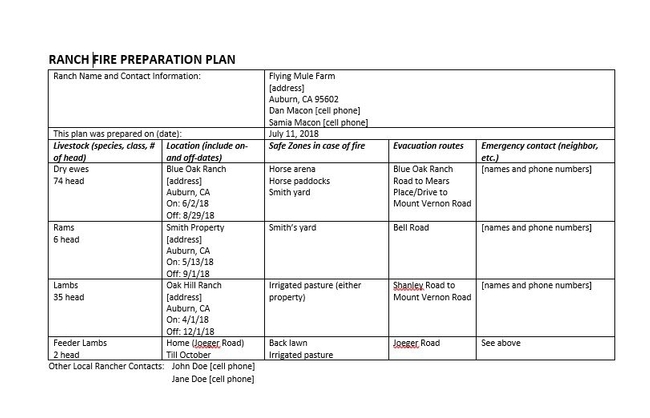
Access to leased pastures during a large-scale fire or other emergency may be more problematic. On Monday, we learned from CalFire that there is a liaison officer within the agency's incident command structure who can help facilitate access to livestock during a multi-day fire. Short-term access may be more difficult - we're working with our local emergency responders to find ways to address this while also protecting public and fire fighter safety.
What steps do you take to prepare for the possibility of wildfire? I hope you'll share your ideas and questions in the comment section below!
And finally, I'm working on organizing similar meetings with first responders in Nevada, Yuba and Sutter Counties. If you operate a commercial ranch, or lease land to a rancher in one of these counties, and would like to get involved, please contact me at dmacon@ucanr.edu.”
Watch for a follow-up blog that will focus on farmer preparation for wild fire or other emergency threats.

